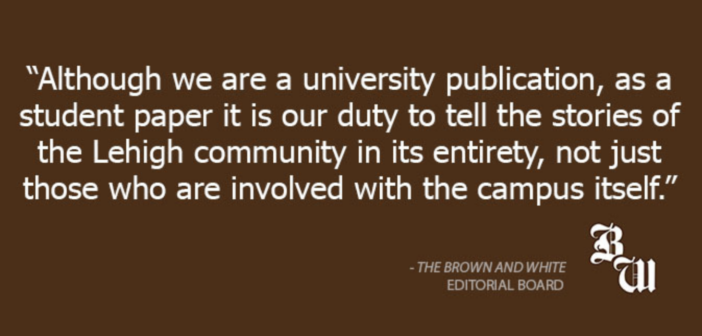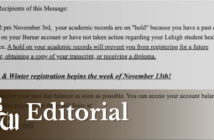Close your eyes and think about your neighborhood at home. Think about the people who live next door, across the street, the apartment down the hall.
Can you name your neighbors? Recall interactions you’ve had? Maybe a handful of memories you’ve made together?
Now think about your residence at Lehigh. Are you off campus? Possibly in a house?
When you think about your neighbors in Bethlehem, who comes to mind? Other students, sure, but can you name South Bethlehem residents who live down the street from you?
On Oct. 21, The Brown and White hosted a community forum to discuss fair representation and racial biases in reporting. Conversations focused both on reporting in mass media as well as in our own student publications.
While the main intent behind these conversations were to deal with race, topics began to hit closer to home — quite literally — as the community spoke about coverage of the South Bethlehem community and Lehigh students’ relationships within it.
Part of the university’s role in the greater Lehigh community involves a commitment to the neighborhood in which the campus is a part. Although we are a university publication, as a student paper it is our duty to tell the stories of the Lehigh community in its entirety, not just those who are involved with the campus itself.
Oftentimes we hear Lehigh students referring to the South Side as “Sketchlehem” or “The Dirty B,” thus giving off the notion that the neighborhood is a less safe and less desirable place to live. Despite these claims, Lehigh students have a history of thoroughly reaping the benefits of off-campus housing, small businesses and a variety of college town bars within the area.
In the face of COVID-19, it is important now more than ever to recognize that Bethlehem is not just a playground. It’s people’s home.
While it may just be our home for four years, there’s multiple generations of families within this community who’ve been raised here and are continuing to raise their families here. They see Lehigh students cycle through their own community and treat it as an extension of a vacation rather than a community to fully appreciate and be a part of.
This is a clear call to action for Lehigh students to make a greater effort to be part of the community in which they live. While they may not have grown up here from a young age, the four years one spends in college are undoubtedly a time of growing up, broadening one’s horizons and gaining a greater perspective on their lives and the impact they wish to have on the world as they become adults.
Everyone who plays a role in setting the tone and attitude for what the community looks like — administrators, Gryphons, faculty and even us as a student publication — impacts how the campus community views and understands what lies beyond the perimeter of our school.
As reporters and editors, we dictate what gets published based on what we pitch. If we aren’t listening to the voices of the entire Lehigh community, how will those lesser known, marginalized voices be heard?
If anything, the conversation held last Wednesday made it clear to us as a paper that it’s time to hand over the mic — or the pitch doc — to residents in South Bethlehem.
While we interact with the South Side a great deal, we are usually coming to them already knowing what questions we need to ask about the given story at hand. We must be better at asking questions on what they care about and report on topics important not just to us, but them as well.
This is just one of many steps we can take to bridge the gap between students and the South Side and rectify this relationship. This community belongs to both groups of people, and it’s time we shake the sense of ownership.
There are many resources on Lehigh’s campus that help to bring the students and residents closer together. Bettering this relationship goes far beyond going to get food or shopping in family-owned businesses.
The Lehigh Community Service Office creates multiple opportunities for students to become more involved and better understand the residents’ backgrounds and lifestyles. Instead of throwing your hands up and saying you don’t know what steps to take, start somewhere that has the opportunities already crafted for you.
It’s easier to go further when we go together. During a time in which the nation is divided in numerous ways, it is incredibly crucial that we get down to a base understanding of each other’s values and mindsets in order to forge forward.






Comment policy
Comments posted to The Brown and White website are reviewed by a moderator before being approved. Incendiary speech or harassing language, including comments targeted at individuals, may be deemed unacceptable and not published. Spam and other soliciting will also be declined.
The Brown and White also reserves the right to not publish entirely anonymous comments.
1 Comment
Remembering the “good ole days” which is not accurate because they were not necessarily good; “The Dirty B,” did not exist as an epithet but would have been appropriate in describing the environment when Bethlehem Steel was making steel and providing jobs. I would imagine many locals would mingle with Lehigh students at athletic events (South Side Boosters and their ilk) and social gatherings (high school female students).
The Lehigh Community Service Office I am sure has improved relations with the community and is a vast improvement over the “good ole days”. I can recall B&W past reporting on several positive community interactions; this editorial is good news in that the Lehigh community desires more of them.